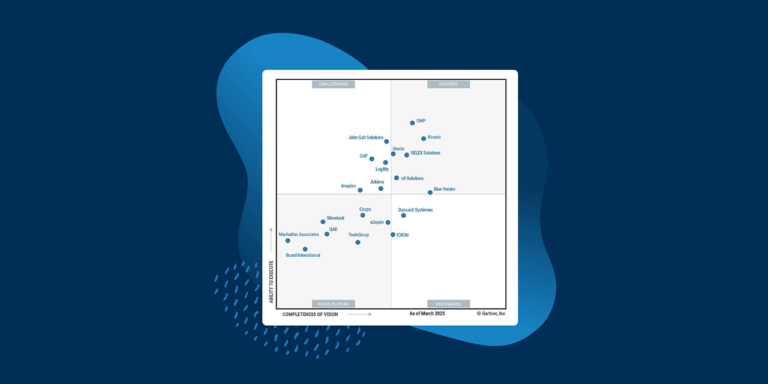NRF 2025 Big Ideas: Solving the consumer demand conundrum
Feb 7, 2025 • 6 minFrom predicting inventory needs, to pricing products smartly to sell, to optimizing store shelves effectively, what are some of the newest strategies for retailers to tackle consumer demand in the most efficient way possible? That is the million-dollar question.
Every industry is different, but consumer behavior is consistent, no matter the industry: “Give me what I need, where I want it, and give it to me now.” This panel, led by RELEX Co-founder and CEO Mikko Kärkkäinen and featuring speakers from Family Dollar, C&S Wholesale Grocers, and Lowe’s, explores how they are tackling the consumer demand conundrum.
Transcript
Mikko Kärkkäinen: My name is Mikko Kärkkäinen. I’m the Chief Executive and Co-founder of RELEX Solutions. The main thing today is hearing about practical examples and practical insight on how to sell and fulfill consumer demand. And with me here on the stage are Kim Ramsey from Family Dollar, Andrew Connell from C&S Wholesale, and Camille Fratanduono from Lowe’s.
Kim Ramsey: Hi, everyone. My name is Kim Ramsey. I’m the Vice President of Inventory Management for Family Dollar. I’ve been there for five and a half years now. And in October of 2022, we implemented RELEX and we have the demand forecasting and replenishment modules.
Andrew Connell: I’m Andrew Connell. I lead procurement at C&S. C&S Wholesale Grocers is the largest wholesale grocery company in the US. I’ve been there for about 18 years. And starting in 2023, we started implementing RELEX. We implemented the forecasting functionality that year. We implemented replenishment last year. So, we’ve been on a two-year journey there and, you know, I’m excited for the conversation today.
Camille Fratanduono: My name is Camille Fratanduono. I lead the inventory team, Senior Vice President of Inventory Planning and Replenishment for Lowe’s. I actually have implemented [RELEX] at three different companies. Once at Vitamin Shoppe, where we did the full replenishment, plan, allocation, and forecasting. Similar at Bed, Bath and Beyond, and then now at Lowe’s, we have their allocation module. So, been a long partner with the RELEX team.
MK: How are you using retail data, data, and machine learning to kind of find out and serve the consumer demand?
AC: So, as a wholesaler, one of the big dilemmas that we have is we’ve got 4,000 independent customers that we do business with. Many, many chain customers across the country that we do business with as well. And, with the RELEX platform, we now have the ability to really utilize data from our customers to help improve our forecast accuracy in our planning.
Same with suppliers. We have thousands and thousands of suppliers that we work with that are all interested in data sharing. Now that we have that capability, we’re talking about what it looks like to share data – to collect data from our customers to utilize in the supply chain process. How to share insights and plans with our suppliers as well.
KR: Yeah, so for us some of our biggest suppliers are CPG vendors and one of the opportunities that we had is that our forecasts were not always aligned. So, they had their forecasts that they were using to place orders. And we had our forecasts that we were using to manage the inventory levels and making sure that the vendors were staying on track.
And so, this year we piloted with one of our biggest suppliers, a vendor collaboration with RELEX. So, our supplier actually has RELEX, their analysts have RELEX dashboards, and they’re able to look at their SKUs, work through their forecasts. So now you have one complete forecast that we’re using as well as the supplier is using. So, it’s been a great benefit for us to get that alignment and make sure that we’re all marching towards the same goals.
MK: Camille, you know a lot about seasons, and they are a big challenge for many companies, actually. Could you share some good examples on how you are managing seasons with allocations?
CF: Yeah, I mean, anyone who’s managed any seasonal categories knows the challenges they present from an inventory perspective and a margin perspective. Earlier on, we were trying to manage the sheer amount of SKU and store locations by using more cluster-based allocation decisions. The change and shift to more item-store-location decisions is really what is unlocking the benefit of improved sell-throughs and markdown exposure.
So, partnering with RELEX as, you know, a third-party solution that could come in and help manage that seasonal process, both from getting a more precise allocation at the item store level, but also a more efficient process. So, the team doesn’t spend all their time analyzing the data, but they’re able to work with the vendors, secure the inventory, improve in-stocks, fill rates, and those things. So, that’s been, in particular, I’d say, one of the shifts that I’ve seen has really helped.
KR: Yeah, I think that’s one of the biggest benefits that we’ve seen from RELEX is the flexibility and the ability to have visibility and the details to any sort of store, SKU, clustering, or grouping that you want to do. And I think that that’s one of the biggest values we’ve gotten out of RELEX – is that ability to get those insights and the visibility to all the different levels.
CF: Yeah, Kim, I would say that visibility is probably one of the biggest things challenges across every, every node of the supply chain, but being able to react more quickly. And that’s one of the things, you know, in terms of an unlock, being able to have that visibility at the item store level and be able to react in some of these, whether you think about weather events or items that go viral, whatever that might be, and be able to react quickly. That visibility is a key to that.
AC: And the ways that we would have reacted to those situations in the past should be different now that we have new systems. The processes that we use to react and to get our customers back in stock should be different, should utilize the capability of the system and the data that we have. Um, and it makes us think differently as a wholesaler about what’s going on at the shelf. How are our customers managing the shelf? What does demand look like in all of the stores? Where is there a disproportionate, uh, amount of demand that we have to focus ourselves on?
So, it gets us closer to our customers, and then we’re able to provide that feedback to suppliers. And by being closer to our customers and being able to share that data back, we’re able to refine how much allocation we truly need to fill the shelf. What our customers are seeing in different parts of the country, in different, in different stores within a chain. So that we can really get to that next level of optimization that wasn’t possible before. It’s the, the experiences that we’ve had over 20 years are really relevant to what we do now in leveraging the RELEX system. But we’re actually saying to ourselves, now that we’ve implemented it, we get to revolutionize all of our processes and improve them.
From a supply chain standpoint, we’re investing heavily in automation within many of our distribution centers. And we see, uh, huge connectivity between our supply chain planning software, RELEX, and really harnessing the value of doing business differently with automation. That’s one of our big focuses.
From a retailer’s standpoint, we’re focused on building a broader set of retail services, uh, and partnerships to enable better, um, value creation for our independent customers. And a big piece of that is extending the data, but also extending the capability of RELEX to our independent customers so that we can execute in the supply chain better together. You know, optimize in-stocks, optimize sales opportunities, and really drive the business.


